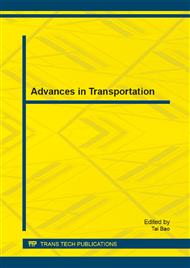p.1183
p.1189
p.1194
p.1199
p.1204
p.1211
p.1215
p.1219
p.1225
Acceptability Analysis of Parking Charges Based on Structural Equation Model
Abstract:
Parking charges is a widely used and effective means to improve parking demand management. Based on the structural equation theory, the model about the influence factors related to the acceptability of parking charges was established. Eight factors were selected for the modeling, including problem perception, willingness, perceived effectiveness, perceived benefits, perceived freedom, perceived fairness, social norms and accountability. And a survey of two charging schemes was undertaken in Nanjing concerning influence factors of the acceptability. Model verification and path coefficient test were conducted based on the established structural equation model by AMOS. It is indicated that the most significant factors affecting the acceptability of parking charges measure are perceived effectiveness and willingness. Finally, according to the conclusions, the suggestions of improving acceptability of parking charges were presented.
Info:
Periodical:
Pages:
1204-1210
Citation:
Online since:
January 2014
Authors:
Price:
Сopyright:
© 2014 Trans Tech Publications Ltd. All Rights Reserved
Share:
Citation:


